Selective Offloading by Exploiting ARIMA-BP for Energy Optimization in Mobile Edge Computing Networks
Abstract
:1. Introduction
- We propose a multi-device framework for task offloading in MEC networks, and we formulate an optimization problem which minimizes the energy consumption and concurrently meets the delay constraints.
- To solve this problem, we devise an efficient strategy, called ABSO (ARIMA-BP-based Selective Offloading). In ABSO, we propose an ARIMA-BP model to estimate computation capacity of the edge cloud, and then design a Selective Offloading Algorithm for obtaining offloading strategy.
2. Related Works
3. System Model
3.1. Scenario Description
3.2. Communication Model
3.3. Computation Model
3.3.1. Local Computing
3.3.2. Mobile Edge Cloud Computing
3.4. Problem Formulation
4. ARIMA-BP-Based Selective Offloading Strategy
4.1. Research Motivation
4.2. Estimation for Computation Capacity of Edge Cloud by ARIMA-BP
4.2.1. Time Series Prediction
ARIMA Model
Prediction of Resource Usage Using Fractional Differencing
4.2.2. Modification of the Residual Error Correction by BP Neural Network
Back Propagation
Modifying the Residual Error Correction
- Compute the remaining sequence used by the CPU.
- Normalize the residual sequence.
- Define the structure of the BP neural network.
- Define the trained parameters of the BP neural network.
- Obtain the residual sequence by the network simulation.
4.2.3. Prediction of CPU Usage by ARIMA-BP
4.2.4. ARIMA-BP for Prediction of Computation Capacity in Edge Cloud
4.3. A Selective Offloading Algorithm
| Algorithm 1 A Selective Offloading Algorithm |
| loop |
| initialize each task computation offloading decision ; |
| for each task do |
| compare local processing time with the latency requirements ; |
| if then |
| update ; |
| else |
| calculate according to (16) and compare with ; |
| if then |
| merge into the set ; |
| else |
| judge Condition 2 again for next time slot; |
| end if |
| end if |
| end for |
| while do |
| tasks in send requests to the edge cloud to compete for the chance of decision-making; |
| if task gain the chance then |
| compare the energy consumption of local execution and edge cloud process ; |
| if then |
| update ; |
| else |
| set ; |
| end if |
| else |
| judge Condition 2 again for next time slot; |
| end if |
| end while |
| end loop |
5. Simulation Results
5.1. Experiment Setup
5.2. Task Offloading Evaluation
- Local execution: All computational tasks are processed locally.
- Full offloading: All computational tasks are executed on edge cloud by offloading.
- Branch and Bound Algorithm (BBA): The objective function is transformed into a question that is binary and linear, and it can be resolved availably by using a branch-and-bound algorithm.
6. Conclusions
Author Contributions
Funding
Conflicts of Interest
References
- Fu, Z.; Ren, K.; Shu, J.; Sun, X.; Huang, F. Enabling personalized search over encrypted outsourced data with efficiency improvement. IEEE Trans. Parallel Distrib. Syst. 2016, 27, 2546–2559. [Google Scholar] [CrossRef]
- Kumar, K.; Lu, Y.H. Cloud computing for mobile users: Can offloading computation save energy. IEEE Comput. 2010, 43, 51–56. [Google Scholar] [CrossRef]
- Abolfazli, S. Cloud-based Augmentation for MobileDevices: Motivation, Taxonomies, and Open Challenges. IEEE Commun. Surv. Tutor. 2014, 16, 337–368. [Google Scholar] [CrossRef]
- Milan, P.; Jerome, J.; Valerie, Y.; Sadayuki, A. Mobile-Edge Computing Introductory Technical White Paper. White Paper. Available online: https://portal.etsi.org/portals/0/tbpages/mec/docs/mobile-edge_computing_-_introductory_technical_white_paper_v1%2018-09-14.pdf (accessed on 14 September 2018).
- Chen, M.; Hao, Y.; Li, Y.; Lai, C.-F.; Wu, D. On the computation offloading at ad hoc cloudlet: Architecture and service modes. IEEE Commun. Mag. 2015, 53, 18–24. [Google Scholar] [CrossRef]
- Fernando, N.; Loke, S.W.; Rahayu, W. Mobile cloud computing: A survey. Future Gener. Comput. Syst. 2013, 29, 84–106. [Google Scholar] [CrossRef]
- Buyya, R.; Yeo, C.S.; Venugopal, S.; Broberg, J.; Brandic, I. Cloud computing and emerging it platforms: Vision, hype, and reality for delivering computing as the 5th utility. Future Gener. Comput. Syst. 2009, 25, 599–616. [Google Scholar] [CrossRef]
- Mao, Y.; You, C.; Zhang, J.; Huang, K.; Letaief, K.B. Mobile edge computing: Survey and research outlook. arXiv, 2017; arXiv:1701.01090. [Google Scholar]
- Shi, W.; Cao, J.; Zhang, Q.; Li, Y.; Xu, L. Edge computing: Vision and challenges. IEEE Internet Things J. 2016, 3, 637–646. [Google Scholar] [CrossRef]
- Liu, J.; Mao, Y.; Zhang, J.; Letaief, K.B. Delay-optimal computation task scheduling for mobile-edge computing systems. In Proceedings of the 2016 IEEE International Symposium on Information Theory (ISIT), Barcelona, Spain, 10–15 July 2016; pp. 1451–1455. [Google Scholar]
- Chen, X.; Jiao, L.; Li, W.; Fu, X. Efficient multi-user computation offloading for mobile-edge cloud computing. IEEE/ACM Trans. Netw. 2016, 24, 2795–2808. [Google Scholar] [CrossRef]
- Yang, S.; Kwon, D.; Yi, H.; Cho, Y.; Kwon, Y.; Paek, Y. Techniques to Minimize State Transfer Costs for Dynamic Execution Offloading in Mobile Cloud Computing. IEEE. Trans. Mob. Comput. 2014, 13, 2648–2660. [Google Scholar] [CrossRef]
- Mao, Y.; Zhang, J.; Letaief, K.B. Dynamic computation offloading for mobile-edge computing with energy harvesting devices. IEEE J. Sel. Areas Common. 2016, 34, 3590–3605. [Google Scholar] [CrossRef]
- Yang, L.; Cao, J.; Cheng, H.; Ji, Y. Multi-user computation partitioning for latency sensitive mobile cloud applications. IEEE Trans. Comput. 2015, 64, 2253–2266. [Google Scholar] [CrossRef]
- Kamoun, M.; Labidi, W.; Sarkiss, M. Joint resource allocation and offloading strategies in cloud enabled cellular networks. In Proceedings of the IEEE International Conference on Communications (ICC), London, UK, 8–12 June 2015; pp. 5529–5534. [Google Scholar]
- Tao, X.; Ota, K.; Dong, M.; Qi, H.; Li, K. Performance Guaranteed Computation Offloading for Mobile-Edge Cloud Computing. IEEE Commun. Mag. 2017, 6, 2162–2345. [Google Scholar] [CrossRef]
- Lyu, X.; Tian, H.; Jiang, L.; Vinel, A.; Maharjan, S.; Gjessing, S.; Zhang, Y. Selective Offloading in Mobile Edge Computing for the Green Internet of Things. IEEE Netw. 2018, 32, 54–60. [Google Scholar] [CrossRef]
- Huang, D.; Wang, P.; Niyato, D. A Dynamic Offloading Algorithm for Mobile Computing. IEEE Trans. Wirel. Commun. 2012, 11, 1991–1995. [Google Scholar] [CrossRef]
- Munoz, O.; Pascual-Iserte, A.; Vidal, J. Optimization of radio and computational resources for energy efficiency in latency-constrained application offloading. IEEE Trans. Veh. Technol. 2015, 64, 4738–4755. [Google Scholar] [CrossRef]
- Zhang, W.; Wen, Y.; Chen, H.-H. Toward transcoding as a service: Energy-efficient offloading policy for green mobile cloud. IEEE Netw. 2014, 28, 67–73. [Google Scholar] [CrossRef]
- Guo, J.; Zhang, H.; Yang, L.; Ji, H.; Li, X. Decentralized Computation Offloading in Mobile Edge Computing Empowered Small-Cell Networks. In Proceedings of the 2017 IEEE Globecom Workshops (GC Wkshps), Singapore, 4–8 December 2017; pp. 1–6. [Google Scholar]
- Baccarelli, E.; Cordeschi, N.; Mei, A.; Panella, M.; Shojafar, M.; Stefa, J. Energy-efficient dynamic traffic offloading and reconfiguration of networked data centers for big data stream mobile computing: Review, challenges, and a case study. IEEE Access 2016, 30, 54–61. [Google Scholar] [CrossRef]
- Taherizadeh, S.; Stankovski, V.; Grobelnik, M. A Capillary Computing Architecture for Dynamic Internet of Things: Orchestration of Microservices from Edge Devices to Fog and Cloud Providers. Sensors 2018, 18, 2938. [Google Scholar] [CrossRef] [PubMed]
- Gong, Z.; Gu, X.; Wilkes, J. PRESS: PRedictive Elastic Resource Scaling for cloud systems. In Proceedings of the International Conference on Network and Service Management (CNSM), Niagara Falls, ON, Canada, 25–29 October 2010; pp. 9–16. [Google Scholar]
- Duggan, M.; Mason, K.; Duggan, J. Predicting host CPU utilization in cloud computing using recurrent neural networks. In Proceedings of the 2017 12th International Conference for Internet Technology and Secured Transactions (ICITST), Cambridge, UK, 11–14 December 2017. [Google Scholar]
- Hao, Y.; Chen, M.; Hu, L.; Hossain, M.S.; Ghoniem, A. Energy Efficient Task Caching and Offloading for Mobile Edge Computing. IEEE Access 2018, 6, 11365–11373. [Google Scholar] [CrossRef]
- Wen, Y.; Zhang, W.; Luo, H. Energy-optimal mobile application execution: Taming resource-poor mobile devices with cloud clones. In Proceedings of the 2012 Proceedings IEEE INFOCOM, Orlando, FL, USA, 25–30 March 2012; pp. 2716–2720. [Google Scholar]
- Chen, M.; Miao, Y.; Hao, Y.; Huang, K. Narrow band Internet of Things. IEEE Access 2017, 5, 20557–20577. [Google Scholar] [CrossRef]
- Nguyen, H.; Shen, Z.; Gu, X.; Subbiah, S.; Wilkes, J. AGILE: Elastic distributed resource scaling for infrastructure-as-a-service. In Proceedings of the 10th International Conference on Autonomic Computing (ICAC), San Jose, CA, USA, 26–28 June 2013; pp. 69–82. [Google Scholar]
- Granero, M.S.; Segovia, J.T.; Prez, J.G. Some comments on Hurst exponent and the long memory processes on capital markets. Phys. A Stat. Mech. Appl. 2008, 387, 5543–5551. [Google Scholar] [CrossRef]
- Hosking, J.R. Fractional differencing. Biometrika 1981, 68, 165–176. [Google Scholar] [CrossRef]
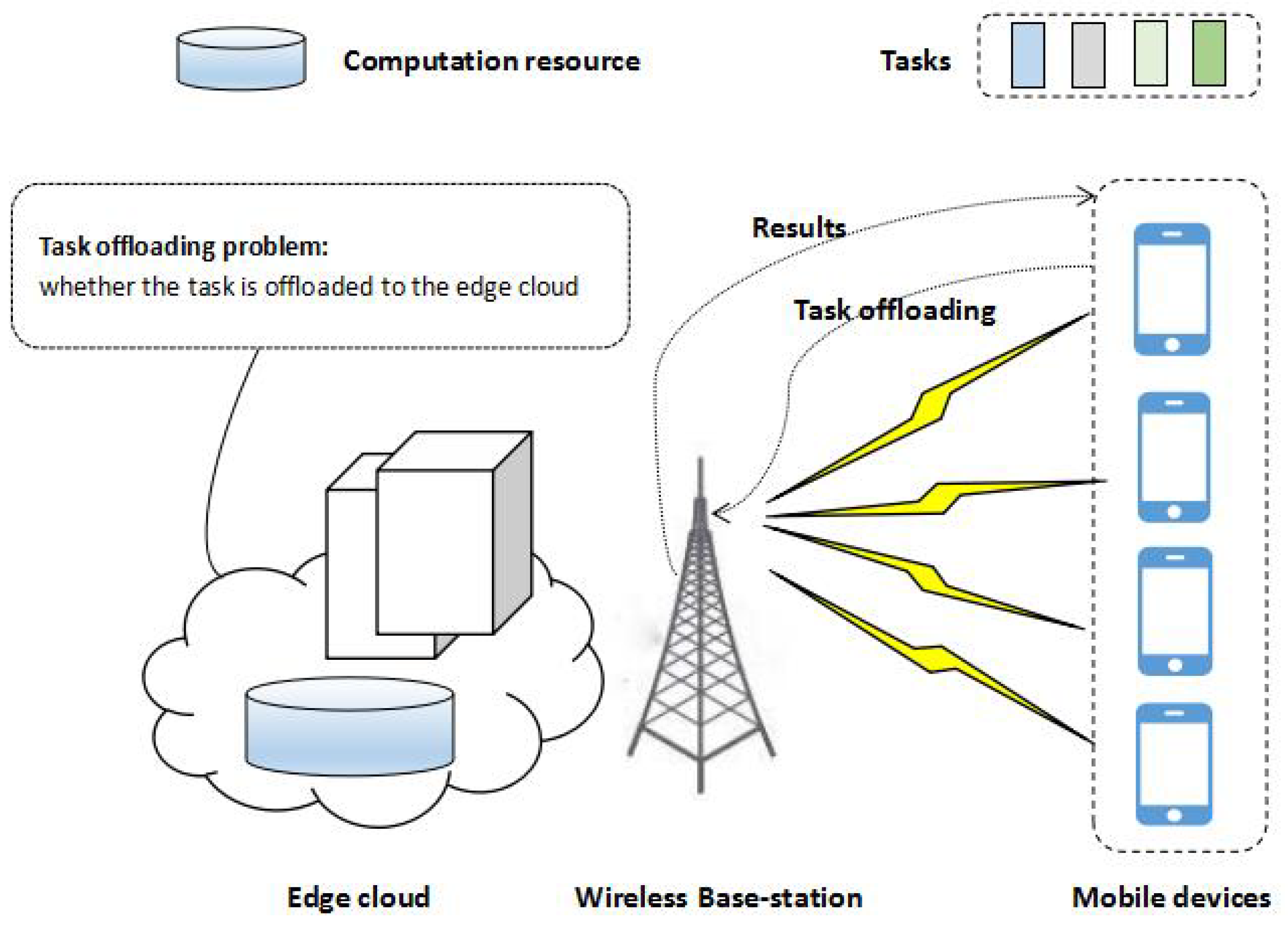
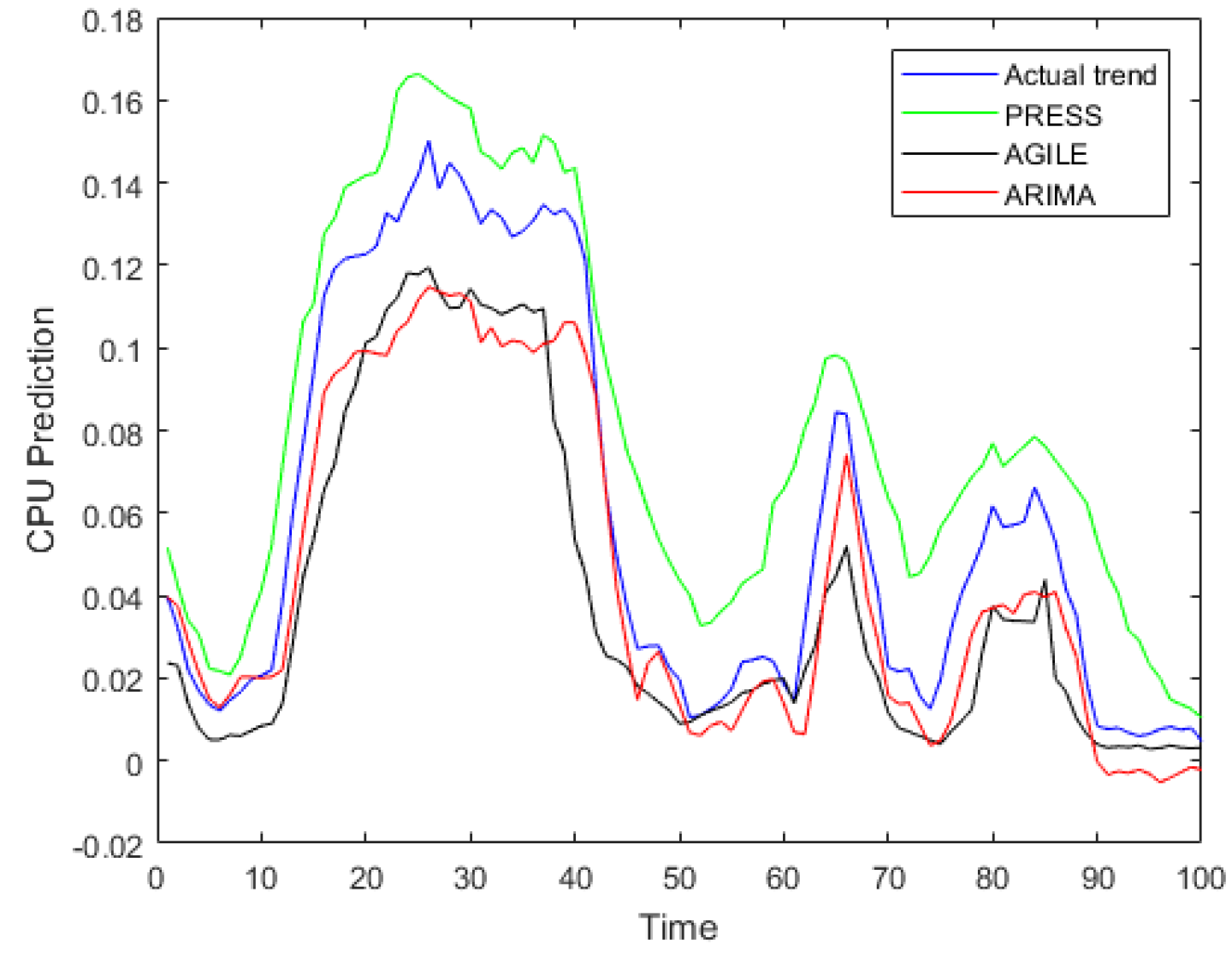
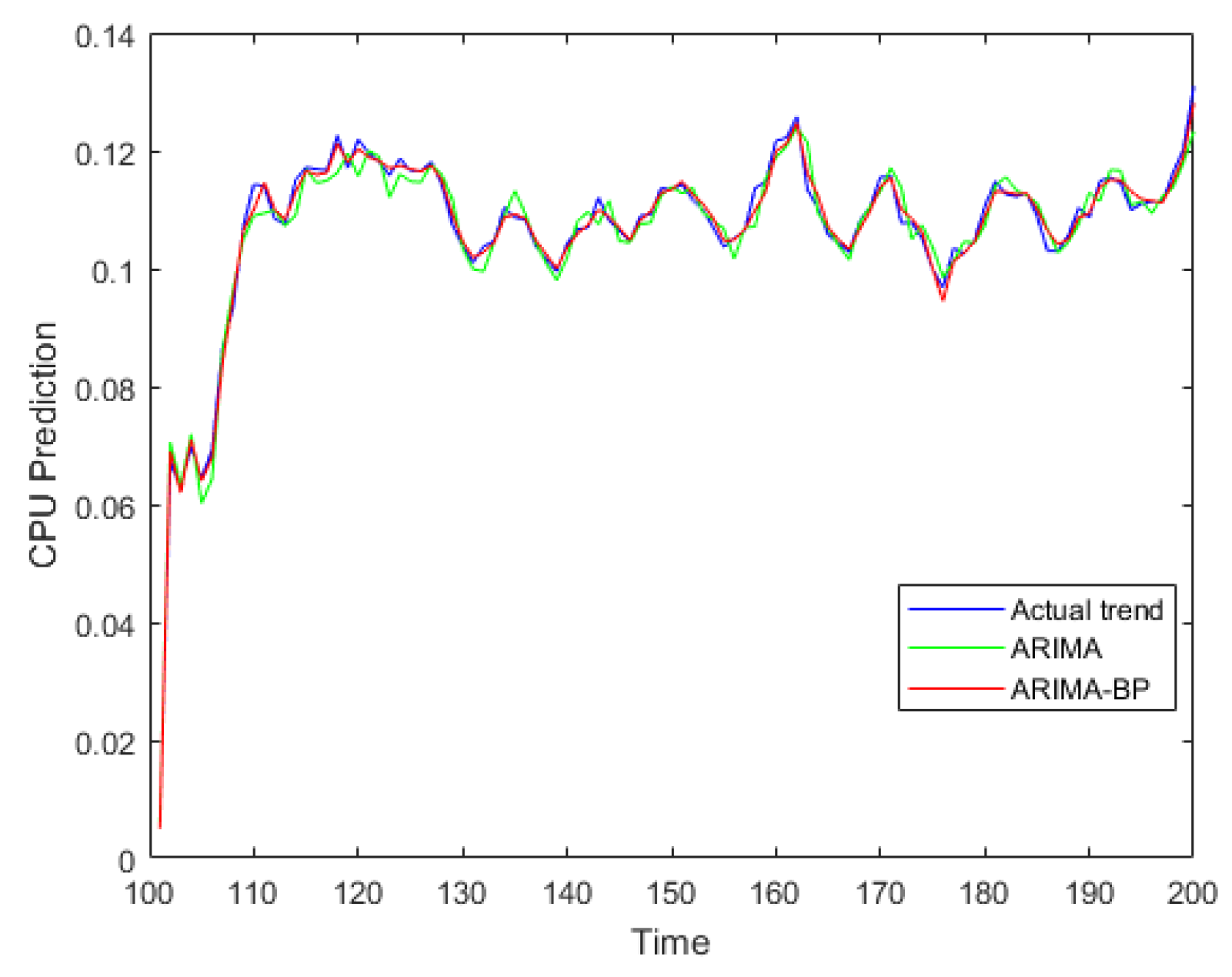
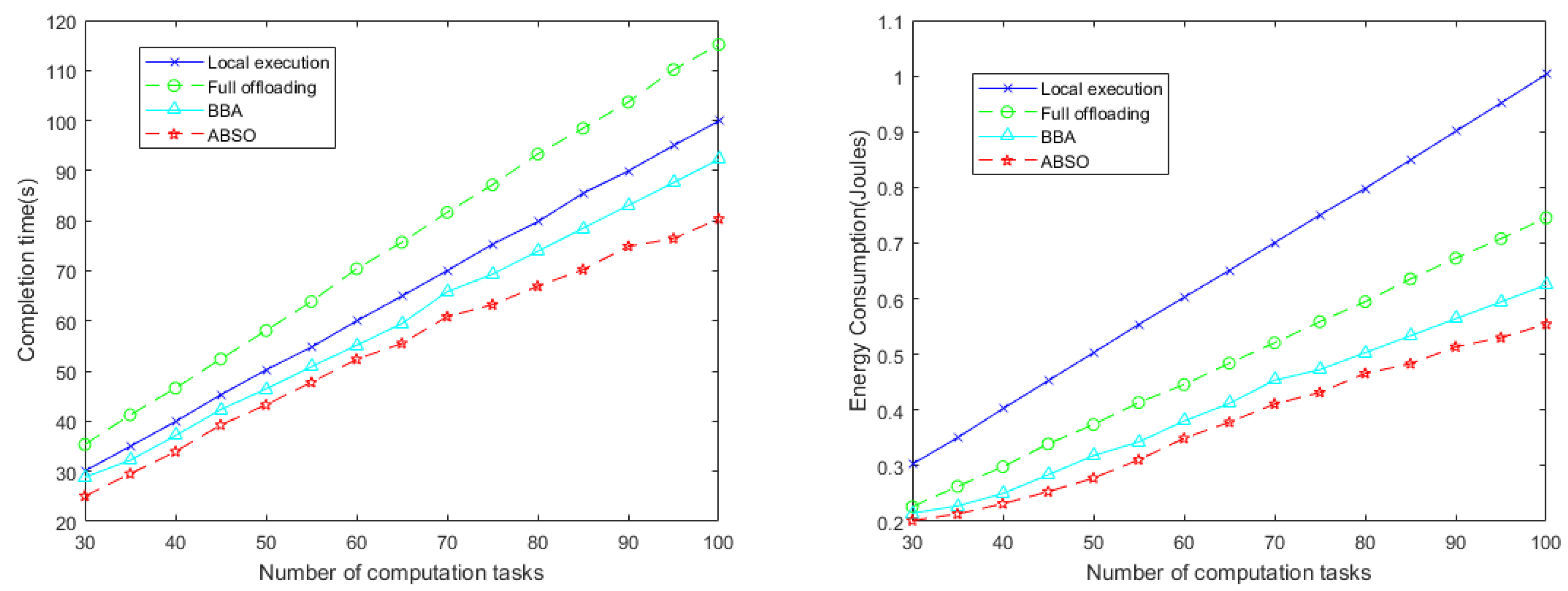
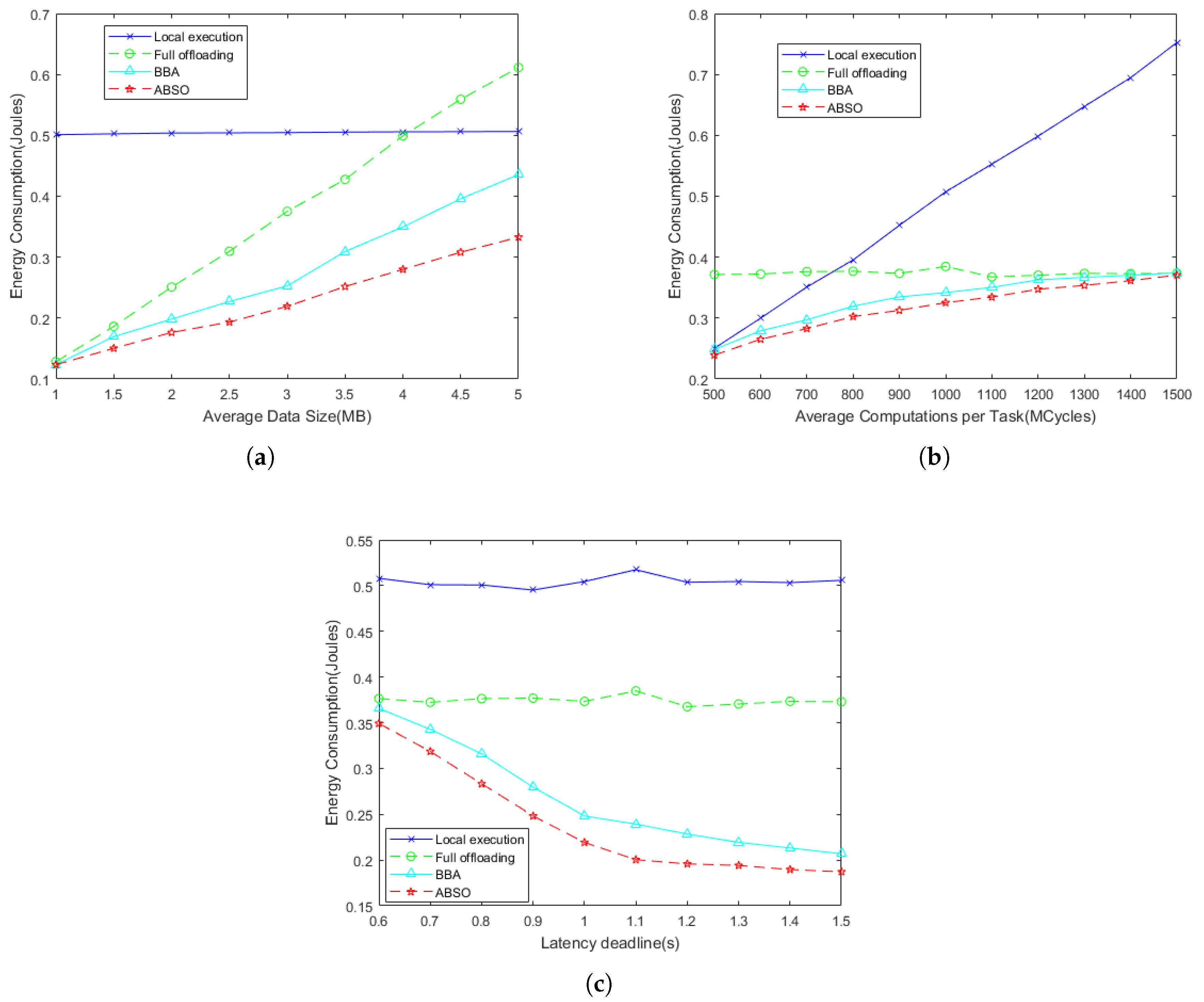
| Without Fractional Difference | With Fractional Difference | |||||
|---|---|---|---|---|---|---|
| 30 Step Ahead | 60 Step Ahead | 90 Step Ahead | 30 Step Ahead | 60 Step Ahead | 90 Step Ahead | |
| PRESS | 0.0294 | 0.0419 | 0.0657 | 0.0167 | 0.0260 | 0.0512 |
| AGILE | 0.0247 | 0.0386 | 0.0526 | 0.0150 | 0.0198 | 0.0453 |
| ARIMA | 0.0213 | 0.0340 | 0.0463 | 0.0122 | 0.0159 | 0.0306 |
| 30 Step Ahead | 60 Step Ahead | 90 Step Ahead | |
|---|---|---|---|
| ARIMA | 0.0139 | 0.0163 | 0.0317 |
| ARIMA-BP | 0.0120 | 0.0126 | 0.0224 |
© 2019 by the authors. Licensee MDPI, Basel, Switzerland. This article is an open access article distributed under the terms and conditions of the Creative Commons Attribution (CC BY) license (http://creativecommons.org/licenses/by/4.0/).
Share and Cite
Zhao, M.; Zhou, K. Selective Offloading by Exploiting ARIMA-BP for Energy Optimization in Mobile Edge Computing Networks. Algorithms 2019, 12, 48. https://doi.org/10.3390/a12020048
Zhao M, Zhou K. Selective Offloading by Exploiting ARIMA-BP for Energy Optimization in Mobile Edge Computing Networks. Algorithms. 2019; 12(2):48. https://doi.org/10.3390/a12020048
Chicago/Turabian StyleZhao, Ming, and Ke Zhou. 2019. "Selective Offloading by Exploiting ARIMA-BP for Energy Optimization in Mobile Edge Computing Networks" Algorithms 12, no. 2: 48. https://doi.org/10.3390/a12020048
APA StyleZhao, M., & Zhou, K. (2019). Selective Offloading by Exploiting ARIMA-BP for Energy Optimization in Mobile Edge Computing Networks. Algorithms, 12(2), 48. https://doi.org/10.3390/a12020048





